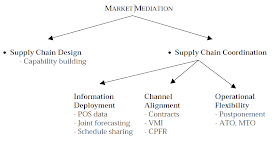Relevance of Enterprise Resource Planning( ERP)-
As per expert, Supply Chain Management supports –
(1) Material
flow
(2) Information
flow
(3) Financial
flow
These flows are
bolstered by three pillars processes,
organizational structures and enabling technologies.Supply Chain Management is not only about specifying
customer zone, manufacturer and distribution selection, allocation of products,
but also about the prioritization of
capabilities to be developed. With this
effective supply chain strategies
depends on exemplary coordination which can be divided in further 3 parts –
(a) Information
deployment – Point-of-sale(POS) data, Joint forecasting , Schedule sharing
(b) Channel
alignment – Contracts , Vendor-managed inventories (VMI), Collaborative
planning forecasting and replenishment (CPFR)
(c) Operational
flexibility – postponement , Assemble-to-order (ATO) , Make-to-order (MTO)
Emergence of IT and SCM transformation collided and created
a requirement for solution which can be critical enabler of superior supply
chain. Enterprise resource planning (ERP) can be seen as combination of
business processes and information technology. ERP converts functional
orientated organization into a process oriented one. Hence require change
management , cross functional initiatives and may lead to complex structures. ERP
is an umbrella term for integrated business software that controls information
structure, controlling a broad range of activities from supplier on floor to
accounting. ERP can provide for
following functionality:
Transaction processing
engine: integrates management of data
throughout the enterprise
Work flow management :
controls numerous process flows that exist in enterprise
Decision support: assists in
creation of plans or deciding in creation of specific customer orders
Limitation of current ERP -
(2) Lack
of flexibility in adapting to
ever-changing supply chain needs
(3) Lack
of more advanced supporting functionality beyond transaction management
(4) Lack
of open, modular, Internet-like system architecture
(5) Information
exchange
Need of the hour –
ERP is going the problem of “ too much information”( TMI)and
“too much software” (TMS). The jumble of ERP, CRM , Supply Chain and BI is
spread all over the globe. A research suggest that CIO and exec accept that
only 64% of enterprise system’s core functions are utilized. Due to company
growth, business line change , new facility, consolidation operations, acquisition
a lot of changes and upgrades are needed in ERP which makes it hard implement
and be successful.
Improving current ERP -
ERP does not have a one-size-fits-all approach. It requires
a lot of customization or requires organization to change the business
processes. Different ERP products offers different degree of specialization
towards different verticals. Another emerging trend is SaaS (Software-as-a-Service) or web-based
software, which can change the integration and implementation trend. The
adoption is still evolving and varies between enterprise application markets
and applicability. But this approach is viable option for small/mid-market
enterprise and it also provide modular way to expand existing business. This 4th
generation computing model represents both an opportunity and challenge. The opportunity is to optimize computing infrastructure,
enterprises while evaluating the challenges/perceptions around the security of
data on the cloud.
Another trend is social
computing, which is helpful in analyzing customer’s proactive and reactive behavior for a firm or product. Social computing technologies provide easy way to provide consumer feedback.
Till this point, social media is limited to business-to-customer(B2C) but
leaders are leveraging social networks for better collaboration with customers,
suppliers and outsourced manufacturers and
other partners. This initiative
can also provide platform to improve internal communication and
collaboration between co-workers and across functional groups and departments.
Mobile device
integration can be utilized in the wake of outstanding network, storage
capacity and broadband speed of new handheld devices. The usage of mobile
devices can result in improved data
accuracy and increased mobility and convenience, thereby streamlining
movement and reducing human errors. This will also improve data validation and
reduce latency while dealing with orders.
These factors can bring huge saving, benefits and usability factors. They are significant reasons to revolutionize the ERP with its relevance to supply chain.
Reference -

Great post. You know we all think about this very topic. Eresource provides manufacturing solutions to midsize Manufacturing Companies with unformed, integrated, on-demand ERP solution generate new revenue streams. erp for manufacturing helps you also cut down production bottlenecks.
ReplyDeleteThanks for sharing such a nice post...
I like the way you start and then conclude your thoughts. Thanks for this nice information.
ReplyDeleteOrder Management Software System